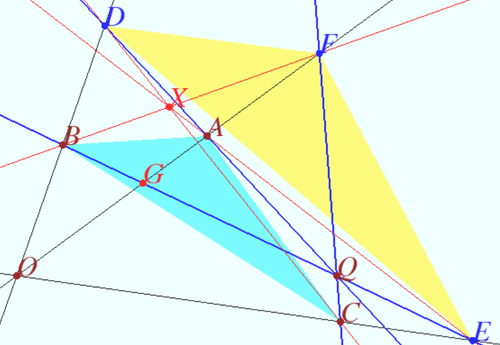Difference between revisions of "Double perspective triangles"
(→Two triangles in double perspective are in triple perspective) |
(→Two triangles in double perspective are in triple perspective) |
||
| Line 11: | Line 11: | ||
It is known that there is projective transformation that maps any quadrungle into square. | It is known that there is projective transformation that maps any quadrungle into square. | ||
| − | We use this transformation for <math>BDFG</math>. We use the | + | We use this transformation for <math>BDFG</math>. |
| + | We use the <i><b>Claim for square</b></i> and get the result: lines <math>AE, BF,</math> and <math>CD</math> are concurrent. | ||
| + | |||
| + | <i><b>Claim for square</b></i> | ||
| + | Let <math>ADBG</math> be the square, let <math>CEGF</math> be the rectangle, <math>A \in FG, G \in BE.</math> | ||
| + | Prove that lines <math>BF, CD,</math> and <math>AE</math> are concurrent. | ||
| + | |||
| + | <i><b>Proof</b></i> | ||
| + | |||
| + | Let <math>BG = a, GE = b, AF = c, A = (0,0).</math> Then | ||
| + | <cmath>B=(− a, − a), F = (0,c), BF: y= x (1 + \frac {c}{a})+c.</cmath> | ||
| + | <cmath>E=(b, − a), AE: y = − \frac {a}{b}x.</cmath> | ||
| + | <cmath>D = (−a,0), C= (b,c), CD: y = c \frac {x+a}{a+b}.</cmath> | ||
| + | <math>X = CD \cap AE \cap BF = (− b, a) \frac {c}{a+b +{\frac {bc}{a}}</math> as desired. | ||
| + | |||
| + | '''vladimir.shelomovskii@gmail.com, vvsss''' | ||
Revision as of 14:41, 5 December 2022
Double perspective triangles
Two triangles in double perspective are in triple perspective
Let ![]() and
and ![]() be in double perspective, which means that triples of lines
be in double perspective, which means that triples of lines ![]() and
and ![]() are concurrent. Prove that lines
are concurrent. Prove that lines ![]() and
and ![]() are concurrent (the triangles are in triple perspective).
are concurrent (the triangles are in triple perspective).
Proof
Denote ![]()
It is known that there is projective transformation that maps any quadrungle into square.
We use this transformation for ![]() .
We use the Claim for square and get the result: lines
.
We use the Claim for square and get the result: lines ![]() and
and ![]() are concurrent.
are concurrent.
Claim for square
Let ![]() be the square, let
be the square, let ![]() be the rectangle,
be the rectangle, ![]() Prove that lines
Prove that lines ![]() and
and ![]() are concurrent.
are concurrent.
Proof
Let ![]() Then
Then
\[B=(− a, − a), F = (0,c), BF: y= x (1 + \frac {c}{a})+c.\] (Error compiling LaTeX. Unknown error_msg)
\[E=(b, − a), AE: y = − \frac {a}{b}x.\] (Error compiling LaTeX. Unknown error_msg)
\[D = (−a,0), C= (b,c), CD: y = c \frac {x+a}{a+b}.\] (Error compiling LaTeX. Unknown error_msg)
$X = CD \cap AE \cap BF = (− b, a) \frac {c}{a+b +{\frac {bc}{a}}$ (Error compiling LaTeX. Unknown error_msg) as desired.
vladimir.shelomovskii@gmail.com, vvsss










